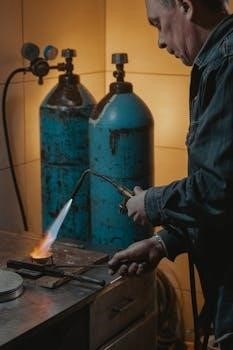
Your Frigidaire countertop ice maker is a sophisticated appliance designed to provide you with a constant supply of ice for your beverages․ It operates through a combination of electrical and mechanical components․
Understanding the Basic Operation of Ice Makers
A portable ice maker‚ such as your Frigidaire model‚ is a compact device engineered to produce ice by freezing water directly from its internal water reservoir․ This process involves several key components working in harmony․ Initially‚ water is pumped from the reservoir into a tray or mold․ A refrigeration system then cools the mold‚ causing the water to freeze into ice cubes․ Once the ice is formed‚ a mechanism releases the cubes into a storage bin․ The entire cycle is controlled by an internal system‚ ensuring efficient and consistent ice production․ Understanding this basic process is essential for effective troubleshooting when issues arise․ The appliance requires proper functioning of each part to operate effectively and produce ice as intended‚ making it crucial to identify any malfunctioning components for repair․

Common Issues with Frigidaire Countertop Ice Makers
Several common problems can affect your Frigidaire ice maker‚ including no ice production‚ reduced ice output‚ smaller cubes‚ longer production times‚ and unusual ice taste․
No Ice Production
If your Frigidaire countertop ice maker isn’t producing any ice‚ several factors could be at play․ Start by ensuring the unit is properly plugged into a functioning power outlet․ Next‚ verify that the ice maker’s power switch is turned on․ A common oversight is a accidentally turned off switch which can prevent ice production․ Also check the water reservoir to confirm it is adequately filled with water․ A lack of water will stop the ice-making process․ Inspect the water intake for any blockages or debris that might prevent water from entering the system․ The water valve might be faulty‚ and a thorough check is needed․ If none of these solves the problem‚ then you need to consult your user manual‚ or a qualified technician․ Don’t forget to check if the unit is in cleaning mode․ This mode will not produce any ice․
Reduced Ice Production or Smaller Cubes
Experiencing reduced ice production or noticing smaller than usual ice cubes from your Frigidaire countertop ice maker can be frustrating․ A primary culprit is often the water filter․ An old or clogged filter will slow down water flow‚ leading to insufficient ice production․ Check when you last replaced the filter; generally‚ they should be replaced every six months․ A partially blocked water intake can also restrict water flow‚ resulting in smaller cubes․ Make sure there is no obstruction present in the intake․ Another reason could be the freezer temperature․ If the freezer temperature is too warm‚ the ice will not freeze properly and may be smaller in size․ Low water levels in the reservoir might cause ice production to slow down․ Make sure that the reservoir has enough water to ensure proper production․ If the issue persists‚ consider seeking assistance from a qualified technician․
Ice Maker Takes Longer Than Usual to Produce Ice
If your Frigidaire countertop ice maker is taking longer than usual to produce ice‚ several factors could be at play․ A common reason is a restricted water supply․ Check the water intake for any obstructions or blockages that may be hindering the water flow․ The water filter may also be the cause․ If it’s clogged or old‚ it will impede the water flow‚ leading to longer ice production times․ Replace the filter if it’s been more than six months․ An improper freezer temperature can slow the ice-making process․ Ensure that the freezer control is set to a colder setting to facilitate the freezing process․ The unit may also be having some issues with internal components․ The motor type noise may not be translating into the ice-making operation․ If all these are checked and the problem is still occurring‚ consider contacting professional help․
Unusual Taste of Ice
An unusual taste in the ice produced by your Frigidaire countertop ice maker can be quite unpleasant․ One of the primary reasons for this is a dirty or contaminated water filter; Over time‚ the filter can accumulate impurities and bacteria‚ leading to off-tasting ice․ Replacing the water filter regularly‚ ideally every six months‚ is essential to maintain the purity of your ice․ Another potential cause is the buildup of mold or mildew within the ice maker․ These can grow in moist environments and impart a musty or unpleasant flavor․ Regularly cleaning the ice maker using a vinegar solution helps eliminate mold and mildew‚ ensuring better-tasting ice․ If these steps do not solve the problem‚ consider the quality of your water source and contact your local water utility for potential issues․

Troubleshooting Steps
When your Frigidaire countertop ice maker malfunctions‚ begin by checking the water supply and intake․ Inspect the water valve and consider examining and replacing the water filter․
Checking the Water Supply and Intake
A common reason for a Frigidaire countertop ice maker not working properly is an issue with its water supply․ Begin by ensuring that the water reservoir is adequately filled․ If the unit is connected to a water line‚ verify that the connection is secure and that there are no kinks or obstructions in the line․ Check for any blockages at the water intake‚ as debris can often clog the opening and prevent water from flowing correctly into the ice maker․ This can lead to reduced ice production or a complete halt in ice making․ A lack of water will prevent the unit from starting its ice-making cycle‚ making it a critical area to inspect․ Make sure there are no blockages preventing the flow․ If you’ve recently moved the appliance‚ check that everything is reconnected and working correctly․
Inspecting the Water Valve
The water valve plays a vital role in directing water to the ice maker’s freezing mechanism․ If your Frigidaire countertop ice maker isn’t producing ice‚ or is making less than usual‚ a faulty water valve could be the reason․ To inspect this‚ first ensure the unit is unplugged from the power source․ Then‚ carefully remove the cover of your ice maker to access the valve area․ Check for any visible signs of damage‚ like cracks or leaks․ Sometimes‚ the valve might be clogged or stuck due to mineral buildup or debris․ Try gently turning the valve mechanism to ensure it moves freely․ If you suspect a problem‚ you may need to disassemble the valve for a thorough examination or consider replacing the water valve if it is not functioning correctly․ Always follow the specific instructions for your model․
Examining and Replacing the Water Filter
A clogged or old water filter is a common culprit behind reduced ice production or unusual tasting ice․ Begin by locating the water filter compartment‚ which is usually inside the ice maker or near the water reservoir․ Carefully remove the filter and examine it for any signs of discoloration‚ debris‚ or damage․ If your filter is older than six months‚ it’s likely time to replace it‚ even if it looks fine․ When installing a new filter‚ make sure it’s properly sealed․ An improperly installed filter can cause water to bypass the filter‚ leading to poor ice quality or reduced water flow․ Follow your user manual for specific steps on filter replacement‚ as each Frigidaire model may have slight variations․ Remember to reset the filter indicator if your machine has one․

Maintenance and Cleaning
Regular maintenance is crucial for your Frigidaire ice maker’s longevity․ Cleaning prevents mold and mildew growth‚ ensuring your ice is safe and clean․ Use a vinegar solution for deep cleaning․
Regular Cleaning and Mold Prevention
Consistent cleaning is paramount to ensure your Frigidaire countertop ice maker operates efficiently and produces safe‚ clean ice․ Mold and mildew can develop in damp environments‚ so regular maintenance is not just for performance‚ but also for hygiene․ Start by unplugging your ice maker to avoid electrical hazards; Empty any remaining water and ice from the unit․ Use a soft cloth or sponge with mild soap and warm water to clean all accessible interior surfaces․ Pay close attention to areas where water tends to accumulate․ Rinse thoroughly with clean water‚ ensuring no soap residue remains․ After cleaning‚ dry all components well with a clean towel to prevent moisture buildup․ Inspect the ice maker for any signs of mold or mildew․ If you spot any‚ address it promptly with a mold-specific cleaner․ Regular cleaning‚ at least once a month‚ will prevent issues and prolong your ice maker’s life․ Don’t forget to clean the exterior as well․
Using Vinegar Solution for Cleaning
A vinegar solution is an effective and natural way to deep-clean your Frigidaire countertop ice maker‚ helping to remove mineral deposits and tough stains․ Begin by creating a mixture of equal parts white vinegar and water․ Ensure your ice maker is unplugged and empty before proceeding․ Pour the vinegar solution into the water reservoir‚ making sure it covers the areas that need cleaning․ Allow the solution to sit for about 30 to 60 minutes․ This allows the vinegar to break down mineral build-up and grime․ After soaking‚ use a soft brush or sponge to scrub the interior components․ Pay special attention to the ice tray‚ the water pump‚ and any other areas where you notice deposits․ Once you’ve completed scrubbing‚ drain the vinegar solution from the ice maker․ Rinse thoroughly with clean water several times to remove any traces of vinegar․ Then‚ dry all interior and exterior parts completely․ Regular use of this method will keep your ice maker clean and efficient․ Finally‚ remember to always operate your ice maker after using this solution to remove any leftover vinegar․

Additional Tips
Ensure the ice maker switch is properly turned on․ Consider purchasing a service warranty for your device‚ as many units tend to have limited lifespans․ These are very important points․
Checking the Ice Maker Switch
One of the simplest yet often overlooked steps in troubleshooting your Frigidaire countertop ice maker is verifying the position of the power or ice maker switch․ This switch can sometimes be accidentally turned off‚ leading to the impression that the entire unit is malfunctioning․ Before diving into more complex troubleshooting steps‚ it is essential to ensure that the switch is in the “on” position․ If‚ after confirming that the switch is on‚ your ice maker still refuses to function‚ it might be necessary to further test the switch using an Ohm meter to check for continuity․ A lack of continuity would indicate a faulty switch that requires either repair or replacement․ A faulty switch can prevent the ice maker from initiating its cycle‚ leading to no ice production․ Checking this is a quick and easy way to rule out a common cause of ice maker issues․
Considering Service Warranties
When facing persistent issues with your Frigidaire countertop ice maker‚ particularly after exhausting basic troubleshooting steps‚ exploring your service warranty options becomes crucial․ Many manufacturers‚ like Frigidaire‚ offer warranties that can cover repairs or even replacements within a specific time frame․ Additionally‚ retailers often provide extended warranties or service plans that offer added protection beyond the manufacturer’s warranty․ Before seeking third-party repair services‚ always check if your appliance is still under warranty‚ as this can significantly reduce the cost of repairs․ These warranties often cover parts and labor‚ making the repair process much more affordable․ Furthermore‚ consider purchasing service warranties for future appliances‚ as they can provide peace of mind and financial security against unexpected breakdowns․ Service warranties are a great safety net that can save you a lot of money over time․
